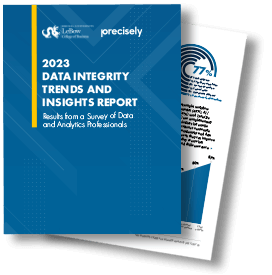Rather than viewing data integration, data quality, location intelligence, and data enrichment as discrete technical capabilities, businesses today must think more holistically about the need for data they can trust for faster, better decision-making.
Precisely views data integrity from a holistic perspective that centers around confidence and trust. For most business users, that means data must be complete and fully available to those who need it, not locked away in data silos. It must be consistent and accurate. It must provide context derived from location intelligence or built from a wider world of available information that can significantly enhance its business value.
These elements are all encompassed in Precisely’s definition of data integrity: accuracy, consistency, and context for confident decision-making. Data integrity is built on the essential elements of data integration, data quality, location intelligence, data enrichment, and data governance.
Let’s look at some of the common data integrity issues that can arise, as well as some key recommendations to avoid them.
1. Poor Data Integration
Even in this age where data integration technology is nearly ubiquitous, many organizations still struggle with data silos for multiple reasons. First, there is the proliferation of systems and data sources throughout virtually every enterprise on the planet. Years ago, when most of an organization’s data might have resided within a few relatively large corporate databases, integration was relatively manageable.
As the number and diversity of systems in use have exploded, the lack of integration has become a bigger problem. Cloud-based systems, mainframes, on-premises databases, and even local spreadsheets and Access databases store information disconnected from other systems and unavailable for sharing or analysis.
2023 Data Integrity Trends & Insights
Results from a Survey of Data and Analytics Professionals

As the number and diversity of systems in use have exploded, lack of integration has become a bigger problem than ever. Cloud-based systems, mainframes, on-premise databases, and even local spreadsheets and Access databases store information disconnected from other systems and unavailable for sharing or analysis.

Nor is it always easy to connect these systems. Point-to-point integration may address some requirements, but it can be difficult to maintain over the long term, especially as you bring new systems online and retire older systems. Inconsistencies in data formats can be a particularly thorny problem, especially when integrating older mainframe systems with data from newer distributed systems.
A permanent solution to data integration challenges must ultimately center around a robust, scalable enterprise integration platform that makes it easy to develop and deploy data pipelines, and that is flexible enough to easily adapt when integration requirements change (as they inevitably will).
2. Poor Data Quality
Without a proactive approach to managing and improving data quality, enterprises will inevitably end up with some portion of their data that is inaccurate, incomplete, and inconsistent across multiple systems. Whenever information changes, such as when a customer moves to a new address or changes their legal name, existing company data may be rendered inaccurate simply because it is out-of-date. This is especially common in the case of customer data which grows less accurate over time.
Accuracy issues may also arise from errors in the data entry process or the acquisition of poor quality data from an external source. Incomplete data can occur when new data elements are added and no provision has been made for updating existing records. Data may be incomplete if integration processes are poorly designed, if you are integrating data that does not match the format into which the data is ingested, or if the datasets you are integrating include disparate fields.
To adequately address these problems, enterprises must take an intentional and proactive approach to data quality management. Achieving that at scale can be challenging unless you deploy a rules-based approach to data quality that builds upon the expertise and domain knowledge of the people in your organization who use the data on a daily basis.
3. Lack of Context Derived from Location
Location intelligence isn’t just about locating customers, competitors, or stores on a map. Virtually every bit of data in the world can be associated with a location in some way. By matching that location to other geospatial attributes, enterprises can open up a whole new world of possibilities for data analytics.

It makes little sense to assess a potential new store site, for example, without understanding the geospatial context of the proposed location. What other businesses are nearby? What about competitors? How much traffic does the location get? Perhaps even more importantly, what kind of traffic is it? Is the location along the thoroughfare that is well-traveled by the customers in your target demographic?
For retail site selection, these kinds of questions sound obvious, but location intelligence can unlock a world of relevant information for virtually any data point. When enterprise data is missing that critical context provided by geospatial insight, your key decision-makers simply don’t have a complete picture of what is most important.
4. Lack of Data Enrichment Leaves Untapped Potential
By augmenting a company’s first-party data with third-party data, data enrichment provides even more opportunities to add completeness and value to your enterprise data. Executives are well aware of this. In fact, according to IDC, 86% of senior leaders surveyed believe that the ability to integrate and derive value from external data will be a critical competency over the next three years.
The addition of third-party data adds context to your existing data. For example, data enrichment may include information such as weather data as it pertains to a particular location, information on the nearest points of interest to a location such as pharmacies and hospitals, or even information regarding the socioeconomic characteristics of a particular neighborhood. Each of these examples is data enrichment in action.
Data enrichment affords companies the opportunity to develop a clear and comprehensive picture of customers, competitors, and supply chains. In a world that is increasingly competitive, data enrichment enables companies to deepen and extend their relationships with their customer.
Precisely partnered with Drexel University’s LeBow College of Business to survey more than 450 data and analytics professionals worldwide about the state of their data programs. Now, we’re sharing the ground-breaking results in the 2023 Data Integrity Trends and Insights Report.







